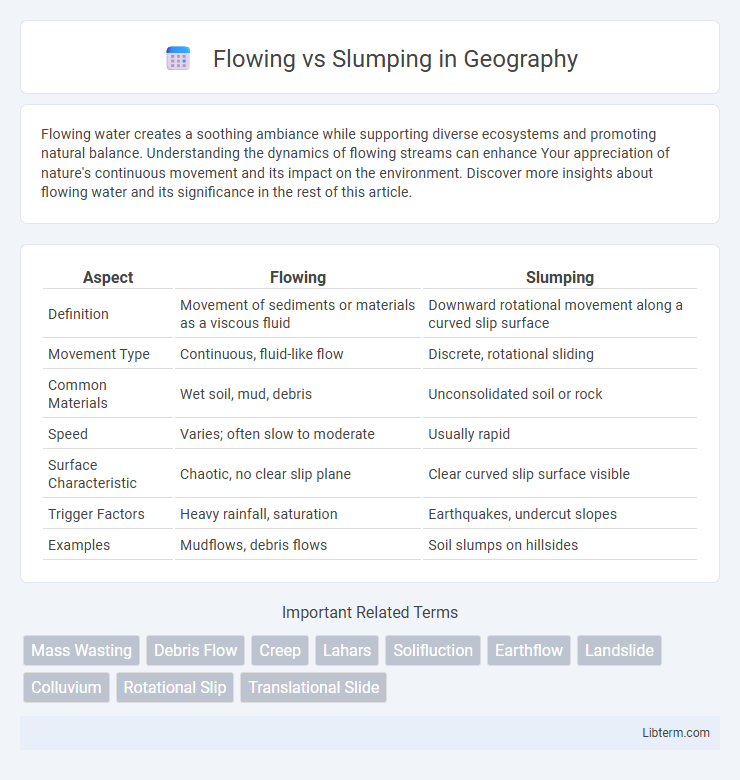Flowing water creates a soothing ambiance while supporting diverse ecosystems and promoting natural balance. Understanding the dynamics of flowing streams can enhance Your appreciation of nature's continuous movement and its impact on the environment. Discover more insights about flowing water and its significance in the rest of this article.
Table of Comparison
| Aspect | Flowing | Slumping |
|---|---|---|
| Definition | Movement of sediments or materials as a viscous fluid | Downward rotational movement along a curved slip surface |
| Movement Type | Continuous, fluid-like flow | Discrete, rotational sliding |
| Common Materials | Wet soil, mud, debris | Unconsolidated soil or rock |
| Speed | Varies; often slow to moderate | Usually rapid |
| Surface Characteristic | Chaotic, no clear slip plane | Clear curved slip surface visible |
| Trigger Factors | Heavy rainfall, saturation | Earthquakes, undercut slopes |
| Examples | Mudflows, debris flows | Soil slumps on hillsides |
Introduction to Flowing and Slumping
Flowing refers to the continuous, smooth movement of materials like liquids or gases driven by gravity or pressure differences. Slumping occurs when a mass of loosely consolidated material moves downward in a more sudden, often blocky manner due to factors like saturation or seismic activity. Understanding the distinction between flowing and slumping is crucial in fields such as geology, civil engineering, and environmental science to predict landform changes and manage hazards.
Defining Flowing: Key Characteristics
Flowing is a type of mass movement characterized by the continuous, fluid-like motion of soil, rock, or debris down a slope, driven primarily by gravity. Key characteristics include a high water content that reduces internal friction and cohesion, resulting in a semi-liquid or plastic behavior that differentiates it from solid or fragmented movement. This process often occurs in saturated soils or loose granular materials, where the velocity and deformation rate vary but maintain a steady, deformable flow pattern distinct from abrupt or blocky slumping.
Understanding Slumping: Essential Features
Slumping is a geological process characterized by the downward and outward movement of soil or rock along a curved surface, typically occurring on a slope. This type of mass wasting involves rotational movement, leading to the formation of slump blocks or terraces that retain some internal cohesion. Key features of slumping include the presence of a scarp at the top, a bulging toe at the bottom, and the displacement of material in a rotational manner, distinguishing it from flowing movements.
Geological Processes Behind Flowing
Flowing in geology refers to the continuous movement of sediment or rock material driven by gravity, often occurring in water or ice-rich environments where particles behave like a viscous fluid. Unlike slumping, which involves the sudden collapse and displacement of a coherent mass along a failure plane, flowing is characterized by a more gradual, plastic deformation without distinct shear surfaces. Key examples include debris flows in mountainous regions and glacier ice movement, both governed by internal deformation and external forces like slope angle and moisture content.
Causes and Triggers of Slumping
Slumping occurs primarily due to the saturation of soil with water, which reduces cohesion and increases the weight, triggering downward movement along a curved slip surface. Factors such as intense rainfall, rapid snowmelt, or artificial irrigation elevate pore-water pressure, destabilizing slopes and initiating slumps. Geological conditions like clay-rich layers, oversteepened slopes, and seismic activity further contribute to slumping by weakening the structural integrity of the soil mass.
Environmental Impact: Flowing vs Slumping
Flowing sediment transport, such as riverine or wind-driven flows, can reshape landscapes gradually while supporting ecosystems through nutrient distribution but may also contribute to erosion and habitat loss if excessive. Slumping, a type of mass wasting where soil or rock detaches and moves downslope, often results in sudden landscape alteration, increased sedimentation in waterways, and disruption of vegetation and animal habitats. Both processes influence soil stability and water quality, with flowing typically affecting large areas over time, while slumping causes localized but immediate environmental impacts.
Human Activities Influencing Flow and Slump
Human activities such as deforestation, construction, and mining significantly influence flow and slump processes by destabilizing slopes and altering natural drainage patterns. Excessive groundwater extraction and improper irrigation increase pore water pressure, triggering flow movements or slumping in susceptible soils. Urban development and road building can weaken soil structure and slope integrity, accelerating mass wasting events like debris flows and rotational slumps.
Case Studies: Notable Flowing and Slumping Events
Notable flowing events include the 1980 Mount St. Helens eruption, where pyroclastic flows devastated large areas with high-speed, dense mixtures of hot gases and volcanic materials. In contrast, the 2018 Anak Krakatau collapse demonstrated slumping, where mass wasting of unstable volcanic flanks led to catastrophic landslides and tsunamis. These case studies highlight the varying dynamics and impacts of flowing versus slumping in volcanic activity and hazards assessment.
Prevention and Mitigation Strategies
Effective prevention of flowing and slumping involves stabilizing slopes through engineered retaining walls, proper drainage systems, and vegetation to reinforce soil structure. Mitigation strategies include real-time monitoring of ground movement using sensors and early warning systems to detect instability before failure occurs. Employing soil nailing and grouting techniques enhances slope strength and reduces the risk of mass wasting events.
Conclusion: Comparing Flowing and Slumping
Flowing and slumping represent distinct sedimentary processes characterized by different motion dynamics and depositional features. Flowing involves continuous, fluid-like movement of sediments, often resulting in well-sorted layers and extensive transport, whereas slumping refers to a rapid, gravity-driven collapse causing disorganized, chaotic deposits with disrupted bedding. Understanding these differences is crucial for interpreting sedimentary environments, reconstructing paleogeographic conditions, and assessing stability in geological formations.
Flowing Infographic

 libterm.com
libterm.com